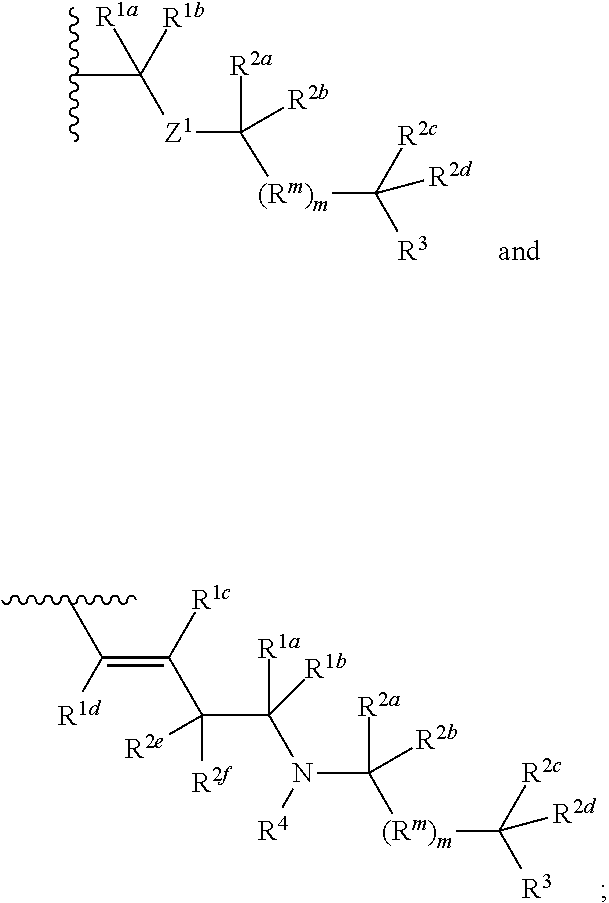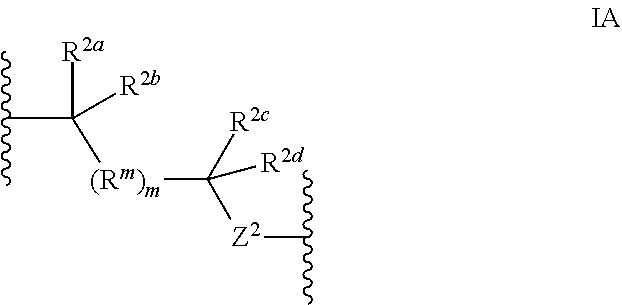Methods of use for compositions comprising a biocidal polyamine
a polyamine and composition technology, applied in the field of polyamine compounds, can solve the problems of compositions, methods may not be limited, and the effect of composition
- Summary
- Abstract
- Description
- Claims
- Application Information
AI Technical Summary
Benefits of technology
Problems solved by technology
Method used
Image
Examples
example 1
[0391]MIC Determination.
[0392]To determine the MIC of the polyamine chains alone and the synthesized compounds against MRSA and P. aeruginosa ATCC 27853, a modified protocol from the Clinical and Laboratory Standards Institute (CLSI) guideline M26-A was used. Consistent with this guideline, the MIC was defined as the concentration of antimicrobial that was required to reduce approximately 5×105 cells per mL to approximately 5×102 per mL in a 24-hour period. Each MIC experiment was performed n=10 times for each antimicrobial. All data was collected using cation adjusted MHB for standardization.
[0393]As mentioned, MRSA and P. aeruginosa ATCC 27853 were grown on Columbia blood agar plates prior to experimentation. From the blood agar plates, a 0.5 McFarland standard was made of each isolate. This equated to approximately 5×107 cells / mL for the MRSA isolate and approximately 3×107 cells / mL for the P. aeruginosa ATCC 27853 isolate. Of the 0.5 McFarland stock solution, 50 μL were added to...
example 2
[0407]A compound was screened for its ability to create zones of inhibition on cation adjusted Mueller Hinton agar. It is believed that the compound of Example 2 may be represented by the structure disclosed in FIG. 4H. To perform this test, lawns of methicillin-resistant Staphylococcus aureus (MRSA) or Pseudomonas aeruginosa ATCC 27853 were made on cation adjusted Mueller Hinton agar using standard microbiological techniques. Immediately after plating bacteria on agar, a 50 μL drop of the compound was placed onto the agar surface. The compound was tested in duplicate at 100 μg / mL, 50 μg / mL, 25 μg / mL and 10 μg / mL. All plates were incubated at 37° C. for 24 hours. Results indicated that total clearing was seen against MRSA at 10 μg / mL. Partial clearing was seen against P. aeruginosa at 25 μg / mL and total clearing at 50 μg / mL.
[0408]The second test determined the minimum inhibitory concentration (MIC) of the compound against MRSA and P. aeruginosa ATCC 27853. In this instance, the MIC ...
example 3
MIC Analysis
[0414]To determine the MIC of polyamine compounds, the protocol described herein was used. The MIC is defined as being the concentration of antimicrobial (in μg / mL) required to reduce the number of bacteria in a solution from 105 colony forming units (CFU) / mL to 102 CFU / mL in a 24-hour period.
[0415]In brief, a 0.5 McFarland of each bacterial isolate was made. A 0.5 McFarland is a measure of turbidity in a liquid sample that contains approximately 1×10̂8 CFU / mL. The 0.5 McFarland standard was diluted in cation adjusted Mueller Hinton Broth (CAMHB), and 50 μL of broth were added to a well of a 96-well plate. In addition, 50 μL of CAMIIB that contained a desired concentration of antimicrobial were also added to the well for a final volume of 100 and a final concentration of approximately 5×104 CFU / well (which equated to approximately 5×105CFU / mL). Each well contained a desired amount of polyamine compound in order to experimentally determine the MIC. Each 96-well plate was ...
PUM
| Property | Measurement | Unit |
|---|---|---|
| concentration | aaaaa | aaaaa |
| volume | aaaaa | aaaaa |
| concentrations | aaaaa | aaaaa |
Abstract
Description
Claims
Application Information
 Login to View More
Login to View More - R&D
- Intellectual Property
- Life Sciences
- Materials
- Tech Scout
- Unparalleled Data Quality
- Higher Quality Content
- 60% Fewer Hallucinations
Browse by: Latest US Patents, China's latest patents, Technical Efficacy Thesaurus, Application Domain, Technology Topic, Popular Technical Reports.
© 2025 PatSnap. All rights reserved.Legal|Privacy policy|Modern Slavery Act Transparency Statement|Sitemap|About US| Contact US: help@patsnap.com



